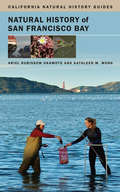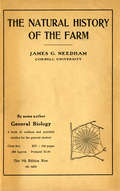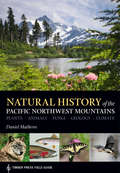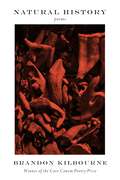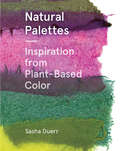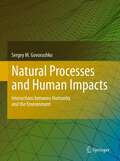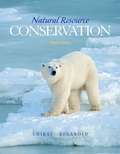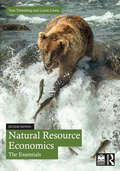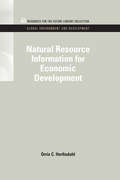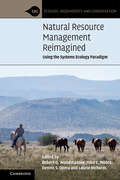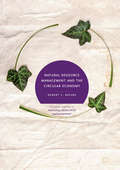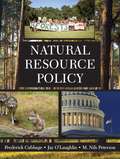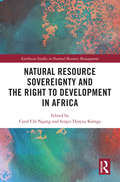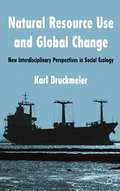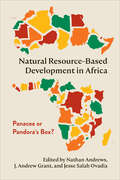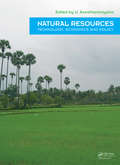- Table View
- List View
Natural History of San Francisco Bay
by Kathleen M. Wong Ariel Rubissow OkamotoThis complete primer on San Francisco Bay is a multifaceted exploration of an extraordinary, and remarkably resilient, body of water. Bustling with oil tankers, laced with pollutants, and crowded with forty-six cities, the bay is still home to healthy eelgrass beds, young Dungeness crabs and sharks, and millions of waterbirds. Written in an entertaining style for a wide audience, Natural History of San Francisco Bay delves into an array of topics including fish and wildlife, ocean and climate cycles, endangered and invasive species, and the path from industrialization to environmental restoration. More than sixty scientists, activists, and resource managers share their views and describe their work--tracing mercury through the aquatic ecosystem, finding ways to convert salt ponds back to tidal wetlands, anticipating the repercussions of climate change, and more. Fully illustrated and packed with stories, quotes, and facts, the guide also tells how San Francisco Bay sparked an environmental movement that now reaches across the country.
Natural History of Silence
by Jérôme SueurIn our busy, noisy world, we may find ourselves longing for silence. But what is silence exactly? Is it the total absence of sound? Or is it the absence of the sound created by humans – the kind of deep stillness you might experience in a remote mountain landscape covered in snow, far away from the bustle of human life? When we listen closely, silence reveals a neglected reality. Neither empty nor singular, silence is instead plentiful and multiple. In this book, eco-acoustic historian Jérôme Sueur allows us to discover a vast landscape of silences which trigger the full gamut of our emotions: anxiety, awe and peace. He takes us from vistas resplendent with full and rich natural silences to the everyday silence of predators as they stalk their prey. To explore silences in animal behaviour and ecology is to discover a counterpoint to the acoustic diversity of the natural world, throwing into sharp relief the grating reverberations of the human activity which threatens it. It is to attune ourselves to a world that our human insensitivities have closed off to us, to take a moment simply to breathe and listen to the place of silence in nature.
Natural History of the Farm: A Guide to the Practical Study of the Sources of Our Living in Wild Nature
by James G. NeedhamThis is a guide to the practical study of the sources in wild nature of our living. It contains a series of study outlines for the entire year, and deals with both the plants and animals of the farm-the things that men have chosen to deal with as a means of livelihood and of personal satisfaction in all ages.
Natural History of the Pacific Northwest Mountains: Timber Press Field Guide (A Timber Press Field Guide)
by Daniel MathewsNatural History of the Pacific Northwest Mountains is an engagingly written, portable history and identification guide for the flora, fauna, and geology of the region. This guide also includes information about the landscape and weather. Packed with 800 color photographs, this is the perfect overview of the Pacific Northwest if you are looking for a simple way to discover the great outdoors.
Natural History: Poems
by Brandon KilbourneA unique work of science and poetry, winner of the Cave Canem Prize, selected by Natasha TretheweyA research biologist most recently at the Museum für Naturkunde in Berlin, Brandon Kilbourne illuminates the intersections between science and poetry in poems that demonstrate the wonder, curiosity, and precision required by both disciplines. Natural History opens by confronting the hidden histories within the study of biology and its links to colonialism, including the revelation that European scientists used slave ships to transport specimens from Africa and the Americas back to Europe. Across the collection, Kilbourne describes how these histories of exploitation are still reflected in dioramas of elephants, rhinoceroses, and African people displayed in natural history museums. Other poems narrate the intricate work of studying fossils, and a longer sequence recounts an expedition above the Arctic Circle to recover evidence of how a fish’s fins gave rise to the diversity of limbs found among amphibians, reptiles, birds, and mammals.Natural History is a rare and fascinating debut, and Kilbourne’s exquisite eye brings the role of the working biologist to life.
Natural Instincts
by Victoria Marie LeesSean isn't looking forward to a family camping trip that includes his new stepsister. She's five years younger than he is, she talks all the time, and she has a pink backpack. It's hard for Sean to imagine that he will ever feel like Christina's big brother.
Natural Interests: The Contest over Environment in Modern France
by Caroline FordChallenging the conventional trope that French environmentalism arose after WWII, Caroline Ford argues that a broad environmental consciousness emerged in France much earlier. In response to war, natural disasters, and imperialism, the bourgeoisie, along with politicians, engineers, naturalists, writers, and painters, took up environmental causes.
Natural Kitchen Dyes: Make Your Own Dyes from Fruit, Vegetables, Herbs and Tea, Plus 12 Eco-Friendly Craft Projects (Crafts Ser.)
by Alicia Hall&“Hall digs into kitchen chemistry in this cozy guide to using plants to make dyes . . . This fun collection will be a valuable addition to any DIY library.&” —Publishers Weekly With Natural Kitchen Dyes you can explore the magical world of natural dyes, without the need of a garden full of dye plants. Our kitchens are a great source of natural dye colors, from vegetable peels that create blush pinks and peaches, fruit skins that make lemon yellows, a green dye sourced from carrot tops, dried spices, and used tea bags to create vibrant yellows, rich terracottas, and deep browns. Natural Kitchen Dyes takes you through the exciting process of creating these wonderful natural colors, dyeing fabric with the dyes, and suggests ingenious ways to get your hands on some natural dye sources. Accompanying the natural dye recipes in the book are ten environmentally conscious projects, which have been created not only to show off the natural dyes beautifully, but to help eliminate waste. Several of the projects actually utilise waste that would otherwise be composted or recycled such as old clothes turned into bags and patchwork floor cushions, to dried pulses past their expiration date used to make a beaded necklace. &“This is my sort of book: no need to start your adventure with a shopping expedition for ingredients—at least not to begin with—it&’s all there in the kitchen for a safe, spur-of-the-moment indulgence.&” —The Journal for Weavers, Spinners & Dyers &“Hall outlines a kid-friendly craft that just might engage adults too.&” —Booklist
Natural Palettes: Inspirational Plant-Based Color Systems
by Sasha Duerr“The plant-lover’s alternative to the Pantone color guide.”—Julia Sherman, creator of Salad for President Renowned natural dyer, artist, and educator Sasha Duerr envisions a new age of fresh, modern color palettes, drawing from our original source of inspiration and ingredients—the natural world around us. This innovative plant-based color guide includes twenty-five palettes with five hundred natural color swatches, providing a bounty of ideas for sustainable fashion, textiles, fine art, floral design, food, medicine, gardening, interior design, and other creative disciplines. Bring the healing power of forest bathing into your home with a palette of spruce cones, pine needles, and balsam branches. Move past Pantone and embrace the natural balance of a pollinator palette with Hopi sunflower, red poppy, echinacea, and scabiosa.Duerr complements her palettes with illuminating reflections on connections between color and landscape, the healing properties of medicinal plants, the ways food and floral waste can be regenerated to enhance lifestyle experiences, the ecological benefits of using natural colors, and more. You may never view color—or the plants that surround us—the same way again.
Natural Processes and Human Impacts
by Sergey M. GovorushkoThis highly topical book comes at a time when the two-way relationship between humankind and the environment is moving inexorably to the top of the agenda. It covers both sides of this delicate balancing act, explaining how various natural processes influence humanity, including its economic activities and engineering structures, while also illuminating the ways in which human activity puts pressure on the natural environment. Chapters analyze a varied selection of phenomena that directly affect people's lives, from geological processes such as earthquakes and tsunamis to cosmic events such as magnetic storms. The author moves on to consider the effect we have on nature, ranging from the impact of heavy industry to the environmental consequences of sport and recreational pastimes. Complete with maps, photographs and detailed case studies, this book provides a comprehensive overview of the biggest issue we face as a species--the way we relate to the natural world around us. This book includes more than 100 maps showing the global distribution of different natural processes/human activities and more that 450 photographs from many countries and all oceans. It will provide a valuable resource for both graduate students and researchers in many fields of knowledge. Sergey Govorushko is a chief research scholar at the Pacific Geographical Institute, Russian Academy of Sciences. He is also Professor at the Far Eastern Federal University (Vladivostok). Sergey Govorushko received his PhD from the Institute of Geography, Russian Academy of Sciences. His research activities focus on the interaction between humanity and the environment, including the impact of nature on humanity; the impact of humanity on the environment; and assessment of the interaction (environmental impact assessment, environmental audit, etc.). He has authored eight and co-authored seven monographs.
Natural Resource Conflicts and Sustainable Development (Earthscan Studies in Natural Resource Management)
by E. Gunilla Olsson Pernille GoochProviding both a theoretical background and practical examples of natural resource conflict, this volume explores the pressures on natural resources leading to scarcity and conflict. It is shown that the causes and driving forces behind natural resource conflicts are diverse, complex and often interlinked, including global economic growth, exploding consumption, poor governance, poverty, unequal access to resources and power. The different interpretations of nature-culture and the role of humans in the ecosystem are often at the centre of the conflict. Natural resource conflicts range from armed conflicts to conflicts of interest between stakeholders in the North as well as in the South. <P><P>The varying driving forces behind such disputes at different levels and scales are critically analysed, and approaches to facilitate and enforce mediation, transformation and collaboration at these levels and scales are presented and discussed. In order to transform existing resource conflicts, as well as to decrease the risk of future conflicts, approaches that enhance and enforce collaboration for sustainable development at global, regional, national and local levels are reviewed, and sustainable pathways suggested. A range of global examples is presented including water resources, fisheries, forests, human–wildlife conflicts, urban environments and the consequences of climate change. It will be a valuable text for advanced students of natural resource management, environment and development studies and peace and conflict management. The book will also be of interest to practitioners in the field of natural resource management.
Natural Resource Conservation: Management For A Sustainable Future
by Daniel Chiras John ReganoldThis comprehensive book describes the ecological principles, policies, and practices required to create a sustainable future. It emphasizes practical, cost-effective, sustainable solutions to these problems that make sense from social, economic, and environmental perspectives. A focus on sustainable development puts readers in touch with one of the most significant shifts in thinking and action in the environmental and resource management arenas. A variety of lasting solutions are provided that make sense from social, economic, and environmental viewpoints.
Natural Resource Economics: The Essentials
by Tom Tietenberg Lynne LewisNatural Resource Economics: The Essentials offers a policy-oriented approach to the increasingly influential field of natural resource economics that is based upon a solid foundation of economic theory and empirical research. Students will not only leave the course with a firm understanding of natural resource economics, but they will also be exposed to a number of case studies showing how underlying economic principles provided the foundation for specific natural resource policies. This key text highlights what insights can be derived from the actual experience.Key features include: Extensive coverage of the major issues, including energy, recyclable resources, water policy, land conservation and management, forests, fisheries, other ecosystems, and sustainable development Introductions to the theory and method of natural resource economics, including externalities, experimental and behavioral economics, benefit-cost analysis, and methods for valuing the services provided by the environment Boxed "Examples" and "Debates" throughout the text, which highlight global cases and major talking points. This second edition provides updated data, new studies, and more international examples. There is a considerable amount of new material, with a deeper focus on climate change. The text is fully supported with end-of-chapter summaries, discussion questions, and self-test exercises in the book, as well as a suite of supplementary digital resources, including multiple-choice questions, simulations, references, slides, and an instructor’s manual. It is adapted from the 12th edition of the best-selling Environmental and Natural Resource Economics textbook by the same authors.
Natural Resource Information for Economic Development (RFF Global Environment and Development Set)
by Raymond F. MikesellThis book discusses the problems of developing quality information on the availability of natural resources. Originally published in 1969
Natural Resource Leadership and Management: A Practical Guide for Professionals (Routledge Focus on Environment and Sustainability)
by Frederick CubbageThis book examines leadership and management in natural resources, drawing on literature, principles, and the author’s own experiences as a leader and activist. Developing a general framework summarizing the leadership and management cycle in natural resources for practitioners, the book provides a synthesis of leadership theory and practice stemming from the personal and spiritual values of work, and the key principle of aligning organizational resources and actions with stated intentions. It discusses the somewhat unique context of natural resources, comprised of private and public goods and services and complex societal values. Key strategies that enable natural resource professionals to be leaders at all stages and positions in their career, including vision and sustainability, proficient human resources management, fairness and merit, and transparency and openness are analyzed. Case studies of famous natural resource leaders and activists, including Ding Darling, David Attenborough, Wangari Maathai, Marina de Silva, Greta Thunberg, Bob Brown, and Christina Koch, are included. The book examines their values, training, and principles and how they influenced national or global natural resource management. Drawing on the author’s own experiences as a leader and activist, including his role as Department Head at North Carolina State University, as an elected officer in the Society of American Foresters, and as an activist opposing the sale of the Hofmann Forest, the book provides practical examples and guidelines that professionals can consider and use in their careers. This book will be of great interest to natural resource managers and professionals as well as students studying environmental management and natural resource governance and to practitioners who are looking to develop broader leadership and management skills.
Natural Resource Management Reimagined: Using the Systems Ecology Paradigm (Ecology, Biodiversity and Conservation)
by John C. Moore Robert G. Woodmansee Dennis S. Ojima Laurie RichardsThe Systems Ecology Paradigm (SEP) incorporates humans as integral parts of ecosystems and emphasizes issues that have significant societal relevance such as grazing land, forestland, and agricultural ecosystem management, biodiversity and global change impacts. Accomplishing this societally relevant research requires cutting-edge basic and applied research. This book focuses on environmental and natural resource challenges confronting local to global societies for which the SEP methodology must be utilized for resolution. Key elements of SEP are a holistic perspective of ecological/social systems, systems thinking, and the ecosystem approach applied to real world, complex environmental and natural resource problems. The SEP and ecosystem approaches force scientific emphasis to be placed on collaborations with social scientists and behavioral, learning, and marketing professionals. The SEP has given environmental scientists, decision makers, citizen stakeholders, and land and water managers a powerful set of tools to analyse, integrate knowledge, and propose adoption of solutions to important local to global problems.
Natural Resource Management and the Circular Economy
by Robert C. BrearsThis book provides insight into how governments are using a variety of innovative fiscal and non-fiscal instruments to develop circular economies with significant economic and environmental benefits. It emphasises the urgent need for these circular economies and to move away from our current, linear model that has led to environmental degradation, volatility of resource prices and supply risks from uneven distribution of natural resources.Natural Resource Management and the Circular Economy illustrates how governments have promoted the development of an economy that can provide substantial net material savings; mitigate price volatility and supply risks; and improve ecosystem health and long-term resilience of the economy. Through a series of case studies, it details the various innovative policy instruments which can be utilised, including regulations; market-based instruments; incentives; research and innovation support; information exchanges; and support for voluntary approaches. The book also proposes a series of best practices for different countries, both developed and developing, who are implementing their circular economy.
Natural Resource Management in the Thar Desert Region of Rajasthan
by Nisha Varghese Sukhdeo Singh Burark K. A. VargheseThis book covers a wide range of issues related to the Thar Desert Region of Rajasthan from an integrated and sustainable development perspective. The chapters in this book cover regional and local issues which are discussed with reference to the past scenario, the present practices, and the future strategies. Some of the issues addressed in this book like arid agroforestry, livelihood, and multidimensional development give it a cutting edge over other related publications currently available in the market. The chapters are supported with relevant pictures which will help the reader to connect with the issues being discussed. This book is useful to students, civil services aspirants, researchers, environmentalists, geographers, and non-professionals who are interested in deserts and desert development.
Natural Resource Policy
by M. Nils Peterson Frederick Cubbage Jay O'LaughlinNatural resource policies provide the foundation for sustainable resource use, management, and protection. Natural Resource Policy blends policy processes, history, institutions, and current events to analyze sustainable development of natural resources. The book's detailed coverage explores the market and political allocation and management of natural resources for human benefits, as well as their contributions for environmental services. Wise natural resource policies that promote sustainable development, not senseless exploitation, promise to improve our quality of life and the environment. Public or private policies may be used to manage natural resources. When private markets are inadequate due to public goods or market failure, many policy options, including regulations, education, incentives, government ownership, and hybrid public/private policy instruments may be crafted by policy makers. Whether a policy is intended to promote intensive management of natural resources to enhance sustained yield or to restore degraded conditions to a more socially desirable state, this comprehensive guide outlines the ways in which natural resource managers can use their technical skills within existing administrative and legal frameworks to implement or influence policy.
Natural Resource Policymaking in Developing Countries: Environment, Economic Growth, and Income Distribution
by William L. Ascher Robert HealyDrawing on case studies developed over a two-year period, 1987-1989, by Fellows in the Program in International Development Policy at Duke University, including experienced representatives from developing countries, the World Bank, and scholars, the authors integrate the growing interest in environmental protection and resource conservation into the existing body of knowledge about the political economy of developing countries. This book is about the links that tie resource use, environmental quality, and economic development, and the way in which those links are affected by the distribution of income and resource ownership. The links may be relatively simple, as in the case of peasant farmers too poor to conserve resources for the future and with nothing to gain from sound environmental practices. Or they may be very complex--as the authors find when they demonstrate how achievement of higher incomes by the rich can increase environmentally destructive behavior by the poor. Many of the links in some way involve rural land use, whether for agriculture or forestry.
Natural Resource Sovereignty and the Right to Development in Africa (Earthscan Studies in Natural Resource Management)
by Carol ChiSerges Ngang Djoyou KamgaThis book explores the nexus between natural resources ownership and the right to development in Africa. The right to sovereignty over natural resources and the right to development are recognised and protected in an extensive framework of international, regional and domestic instruments. They guarantee people's entitlement to fully and freely utilise their natural resources as a means of subsistence and for economic, social and cultural development. Yet, despite the abundance of natural resources in Africa a majority of the people on the continent remain largely impoverished. This book articulates the central argument that to achieve the right to development in Africa requires appropriate governance of the continent’s natural resources to which the people of Africa are guaranteed sovereign ownership. With case study illustrations from Zimbabwe, Ghana, Ethiopia and the Democratic Republic of Congo, chapters explore the normative measures, specific guarantees and community entitlements to natural resources for the realisation of the right to development. The book will be an invaluable guide to scholars and postgraduate students of Natural Resources, Development and African studies as well as policymakers and practitioners in these areas.
Natural Resource Use and Global Change
by Karl BruckmeierBuilding on recent developments in social ecology, this book advances a new critical theory of society and nature, exploring social metabolism and global resource flows in contemporary society. Barriers to global sustainability are identified and conditions for transforming industrial economies towards new sustainable resource use are described.
Natural Resource-Based Development in Africa: Panacea or Pandora’s Box?
by Nathan Andrews J. Andrew Grant Jesse Salah OvadiaThere is no question that Africa is endowed with abundant natural resources of different magnitudes. However, more than a decade of high commodity prices and new hydrocarbon discoveries across the continent has led countless international organizations, donor agencies, and non-governmental organizations to devote considerable attention to the potential of natural resource–based development. Natural Resource–Based Development in Africa places a particular emphasis on the actors that help us understand the extent to which resources could be transformed into broader developmental outcomes. Based on a wide variety of primary sources and fieldwork, including in-person interviews and participant observations, this collection contributes to both scholarly and policy discussions around the governance and economic development roles of local entrepreneurs, transnational firms, civil society groups, local communities, and government agencies in Africa’s natural resource sectors. Natural Resource–Based Development in Africa explores the impact that these actors have on regional trends such as resource nationalism and local procurement policies as well as grassroots-related issues such as poverty, livelihoods, gender equity, development, and human security.
Natural Resources
by Jasper S. LeeNatural Resources covers the following topics: IMPORTANCE OF NATURAL RESOURCES CONSERVING RENEWABLE NATURAL RESOURCES LAND CONSERVING NONRENEWABLE NATURAL RESOURCES SUSTAINING NATURAL RESOURCES ENJOYING NATURAL RESOURCES
Natural Resources - Technology, Economics & Policy
by U. AswathanarayanaNatural resources management has two principal dimensions : Science-illuminated (earth, space, hydrological, pedological, information, etc. sciences) management of local resources (waters, soils, bioresources, minerals, rocks, sediments, etc.) in an ecologically-sustainable manner, and Value-addition through processing of natural products, through
